Vortex Suppression and Flow Pattern Analysis of a Hydrofoil with Parallel Grooves
Abstract
1. Introduction
2. Computational Fluid Domain and Groove Design
2.1. Computational Fluid Domain
2.2. Design Scheme of Parallel Groove
3. Mesh Generation and Numerical Method
3.1. Mesh Arrangement
3.2. Numerical Setting
4. Results and Discussion
4.1. Numerical Method Validation
4.2. Comparison of Groove Location and Spacing
4.3. Analysis on Flow Characteristics and Vortex
5. Expectation
6. Conclusions
- (1)
- Compared with the structure without parallel grooves, the presence of the grooves will lead to a decrease in the lift-to-drag ratio of the hydrofoil within 5%, but it can effectively suppress the development TLV and reduce the area of TLV. This is of great significance for improving the flow stability and studying the optimal design of hydraulic machinery.
- (2)
- The location and spacing of the parallel grooves have a greater effect on the flow characteristics of the hydrofoil. With the backward movement of the groove location, the tendency of TLV to move backward slows down, and the vortex intensity of the GLV gradually decreases, which can produce a local area with smaller velocity. With the increase of the spacing, the effect of increasing the high-speed region is more obvious, and the flow in the low-speed region is mixed with the PTLV in the high-speed region.
- (3)
- The parallel grooves destroy the structure of PTLV and STLV, and inhibits the development of TLV. In order to balance the TLV suppression effect and the energy performance of the hydrofoil, the L3T1 structure is recommended.
- (4)
- The presence of parallel grooves leads to a local low-pressure area, which affects the pressure difference between the pressure side and the suction side, which in turn affects the work done by the hydrofoil and slightly reduces the lift-to-drag ratio.
Author Contributions
Funding
Conflicts of Interest
References
- Zhang, W.; Xie, X.; Zhu, B.; Ma, Z. Analysis of phase interaction and gas holdup in a multistage multiphase rotodynamic pump based on a modified Euler two-fluid model. Renew. Energy 2021, 164, 1496–1507. [Google Scholar] [CrossRef]
- Zhang, W.; Zhu, B.; Yu, Z. Characteristics of bubble motion and distribution in a multiphase rotodynamic pump. J. Pet. Sci. Eng. 2020, 193, 107435. [Google Scholar] [CrossRef]
- Yan, H.; Su, X.; Zhang, H.; Huang, J.; Zhou, L.; Liu, Z.; Wang, Z. Design approach and hydrodynamic characteristics of a novel bionic airfoil. Ocean Eng. 2020, 216, 108076. [Google Scholar] [CrossRef]
- Bai, X.; Cheng, H.; Ji, B.; Long, X. Spatial and spectral investigation of turbulent kinetic energy in cavitating flow generated by Clark-Y hydrofoil. J. Hydrodyn. 2020, 32, 175–178. [Google Scholar] [CrossRef]
- Kinsey, T.; Dumas, G.; Lalande, G.; Ruel, J.; Mehut, A.; Viarouge, P.; Lemay, J.; Jean, Y. Prototype testing of a hydrokinetic turbine based on oscillating hydrofoils. Renew. Energy 2011, 36, 1710–1718. [Google Scholar] [CrossRef]
- Kinsey, T.; Dumas, G. Computational fluid dynamics analysis of a hydrokinetic turbine based on oscillating hydrofoils. J. Fluids Eng. 2012, 134, 021104. [Google Scholar] [CrossRef]
- Zhang, W.; Chen, Z.; Zhu, B.; Zhang, F. Pressure fluctuation and flow instability in S-shaped region of a reversible pump-turbine. Renew. Energy 2020, 154, 826–840. [Google Scholar] [CrossRef]
- Zhang, P.; Duan, M.; Ma, J. A precise mathematical model for geometric modeling of wire rope strands structure. Appl. Math. Model. 2019, 76, 151–171. [Google Scholar] [CrossRef]
- Zhang, P.; Ma, J.; Duan, M.; Yuan, Y.; Wang, J. A high-precision curvature constrained Bernoulli–Euler planar beam element for geometrically nonlinear analysis. Appl. Math. Comput. 2021, 397, 125986. [Google Scholar]
- Dang, Z.; Mao, Z.; Tian, W. Reduction of hydrodynamic noise of 3d hydrofoil with spanwise microgrooved surfaces inspired by sharkskin. J. Mar. Sci. Eng. 2019, 7, 136. [Google Scholar] [CrossRef]
- Zhang, L.; Duan, J.; Da, L.; Xu, G.; Sun, X. Vibroacoustic radiation and propagation properties of slender cylindrical shell in uniform shallow sea. Ocean Eng. 2020, 195, 106659. [Google Scholar] [CrossRef]
- Bai, X.; Cheng, H.; Ji, B.; Long, X.; Qian, Z.; Peng, X. Comparative Study of different vortex identification methods in a tip-leakage cavitating flow. Ocean Eng. 2020, 207, 107373. [Google Scholar] [CrossRef]
- Chen, F.; Zhang, L.; Huai, X.; Li, J.; Zhang, H.; Liu, Z. Comprehensive performance comparison of airfoil fin PCHEs with NACA 00XX series airfoil. Nucl. Eng. Des. 2017, 315, 42–50. [Google Scholar] [CrossRef]
- Hoseinzadeh, S.; Bahrami, A.; Mirhosseini, S.M.; Sohani, A.; Heyns, S. A detailed experimental airfoil performance investigation using an equipped wind tunnel. Flow Meas. Instrum. 2020, 72, 101717. [Google Scholar] [CrossRef]
- Miorini, R.L.; Wu, H.; Katz, J. The internal structure of the tip leakage vortex within the rotor of an axial waterjet pump. J. Turbomach. 2012, 134, 031018. [Google Scholar] [CrossRef]
- Zhang, J.; Fan, H.; Zhang, W.; Xie, Z. Energy performance and flow characteristics of a multiphase pump with different tip clearance sizes. Adv. Mech. Eng. 2019, 11, 1687814018823356. [Google Scholar] [CrossRef]
- Jung, Y.; Choi, M.; Park, J.Y.; Baek, J.H. Effects of recessed blade tips on the performance and flow field in a centrifugal compressor. Proc. Inst Mech. Eng. Part A J. Power Energy 2013, 227, 157–166. [Google Scholar] [CrossRef]
- Decaix, J.; Balarac, G.; Dreyer, M.; Farhat, M.; Munch, C. RANS and LES computations of the tip-leakage vortex for different gap widths. J. Turbul. 2015, 16, 309–341. [Google Scholar] [CrossRef]
- Zhou, K.; Zhou, C. Unsteady effects of vortex interaction on tip leakage vortex breakdown and its loss mechanism. Aerosp. Sci. Technol. 2018, 82, 363–371. [Google Scholar] [CrossRef]
- Boudet, J.; Jacob M, C.; Caro, J.; Jondeau, E.; Li, B. Wavelet Analysis of a Blade Tip-Leakage Flow. AIAA J. 2018, 56, 3332–3336. [Google Scholar] [CrossRef]
- Wang, L.; Lu, J.; Liao, W.; Zhao, Y.; Wang, W. Numerical simulation of the tip leakage vortex characteristics in a semi-open centrifugal pump. Appl. Sci. 2019, 9, 5244. [Google Scholar] [CrossRef]
- Shen, X.; Zhang, D.; Xu, B.; Shi, W.; BPM, v.E. Experimental and numerical investigation on the effect of tip leakage vortex induced cavitating flow on pressure fluctuation in an axial flow pump. Renew. Energy 2021, 163, 1195–1209. [Google Scholar]
- Seo, S.H.; Hong C, H. Performance improvement of airfoils for wind blade with the groove. Int. J. Green Energy 2016, 13, 34–39. [Google Scholar] [CrossRef]
- Liu, Y.; Li, P.; He, W.; Jiang, K. Numerical study of the effect of surface grooves on the aerodynamic performance of a NACA 4415 airfoil for small wind turbines. J. Wind Eng. Ind. Aerodyn. 2020, 206, 104263. [Google Scholar] [CrossRef]
- Yang, X.; Zhao, Q.; Liu, Z.; Feng, Z.; Simon, T. Controlling Leakage Flows Over a Rotor Blade Tip Using Air-Curtain Injection: Part I—Aero-Thermal Performance of Rotor Tips. In the proceedings of Turbo Expo: Power for Land, Sea, and Air. Am. Soc. Mech. Eng. 2019, 58653, V05BT18A002. [Google Scholar]
- Jiang, S.; Chen, F.; Yu, J.; Chen, S.; Song, Y. Treatment and optimization of casing and blade tip for aerodynamic control of tip leakage flow in a turbine cascade. Aerosp. Sci. Technol. 2019, 86, 704–713. [Google Scholar] [CrossRef]
- Sarpkaya, T. Computational methods with vortices—The 1988 Freeman scholar lecture. J. Fluids Eng. 1989, 111, 5–52. [Google Scholar] [CrossRef]
- Pereira, L.A.A.; Hirata, M.H.; Silveira Neto, A. Vortex method with turbulence sub-grid scale modelling. J. Braz. Soc. Mech. Sci. Eng. 2003, 25, 140–146. [Google Scholar] [CrossRef]
- Gupta, S. Development of a Time-Accurate Viscous Lagrangian Vortex Wake Model for Wind Turbine Applications. Ph.D. Thesis, University of Maryland, College Park, MD, USA, 2006. [Google Scholar]
- Hirata, M.H.; Pereira, L.A.A.; Recicar, J.N.; Moura, W.H. High Reynolds number oscillations of a circular cylinder. J. Braz. Soc. Mech. Sci. Eng. 2008, 30, 304–312. [Google Scholar] [CrossRef][Green Version]
- Khatir, Z.; Lucey, A.D. A combined boundary integral and vortex method for the numerical study of three-dimensional fluid flow systems. Int. J. Comput. Math. 2012, 89, 1504–1524. [Google Scholar] [CrossRef]
- Kornev, N.; Samarbakhsh, S. Large Eddy Simulation with direct resolution of subgrid motion using a grid free vortex particle method. Int. J. Heat Fluid Flow 2019, 75, 86–102. [Google Scholar] [CrossRef]
- Dreyer, M.; Decaix, J.; Münch-Alligné, C.; Farhat, M. Mind the gap: A new insight into the tip leakage vortex using stereo-PIV. Exp. Fluids 2014, 55, 1–13. [Google Scholar] [CrossRef]
- Fan, H.; Zhang, J.; Zhang, W.; Fharhat, M. Multiparameter and multiobjective optimization design based on orthogonal method for mixed flow fan. Energies 2020, 13, 2819. [Google Scholar] [CrossRef]
- Huang, Z.; Huang, Z.; Fan, H. Influence of C groove on energy performance and noise source of a NACA0009 hydrofoil with tip clearance. Renew. Energy 2020, 159, 726–735. [Google Scholar] [CrossRef]
- Hu, Z.; Huang, C.; Huang, Z.; Zhang, J. A Method of Bending Shrinkage Groove on Vortex Suppression and Energy Improvement for a Hydrofoil with Tip Gap. Processes 2020, 8, 1299. [Google Scholar] [CrossRef]
- Cheng, H.; Long, X.; Ji, B.; Peng, X.; Farhat, M. Suppressing tip-leakage vortex cavitation by overhanging grooves. Exp. Fluids 2020, 61, 1–18. [Google Scholar] [CrossRef]
- Legras, G.; Gourdain, N.; Trebinjac, I. Numerical analysis of the tip leakage flow field in a transonic axial compressor with circumferential casing treatment. J. Therm. Sci. 2010, 19, 198–205. [Google Scholar] [CrossRef]
- Zhang, J.; Zhang, Q.; Wang, H.; Ye, P. Study on heat transfer performance of shaft seal in HTR-PM circulator. In Proceedings of the International Conference on Nuclear Engineering (ICONE), Tsukuba, Japan, 19–24 May 2019; p. 1776. [Google Scholar]

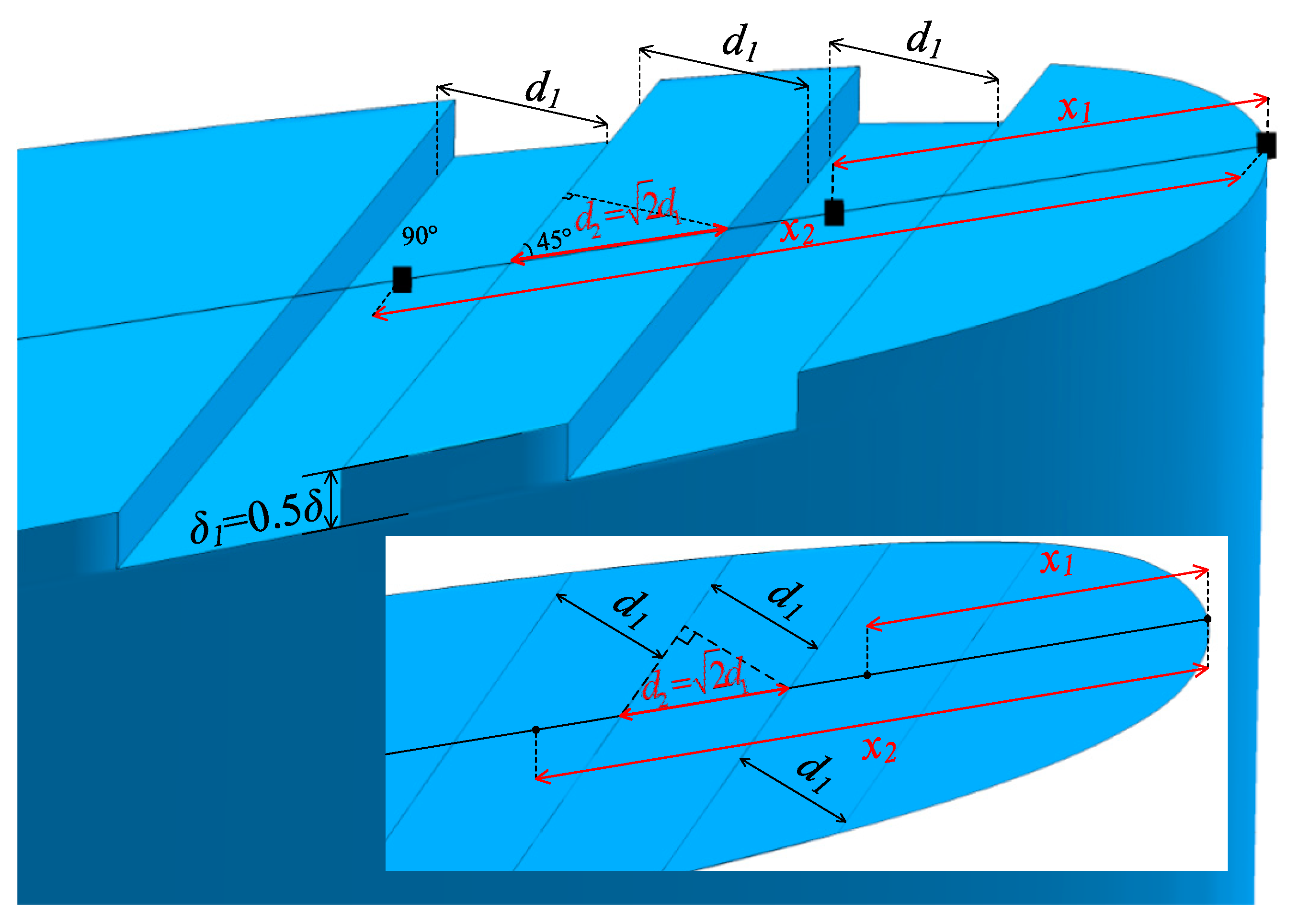
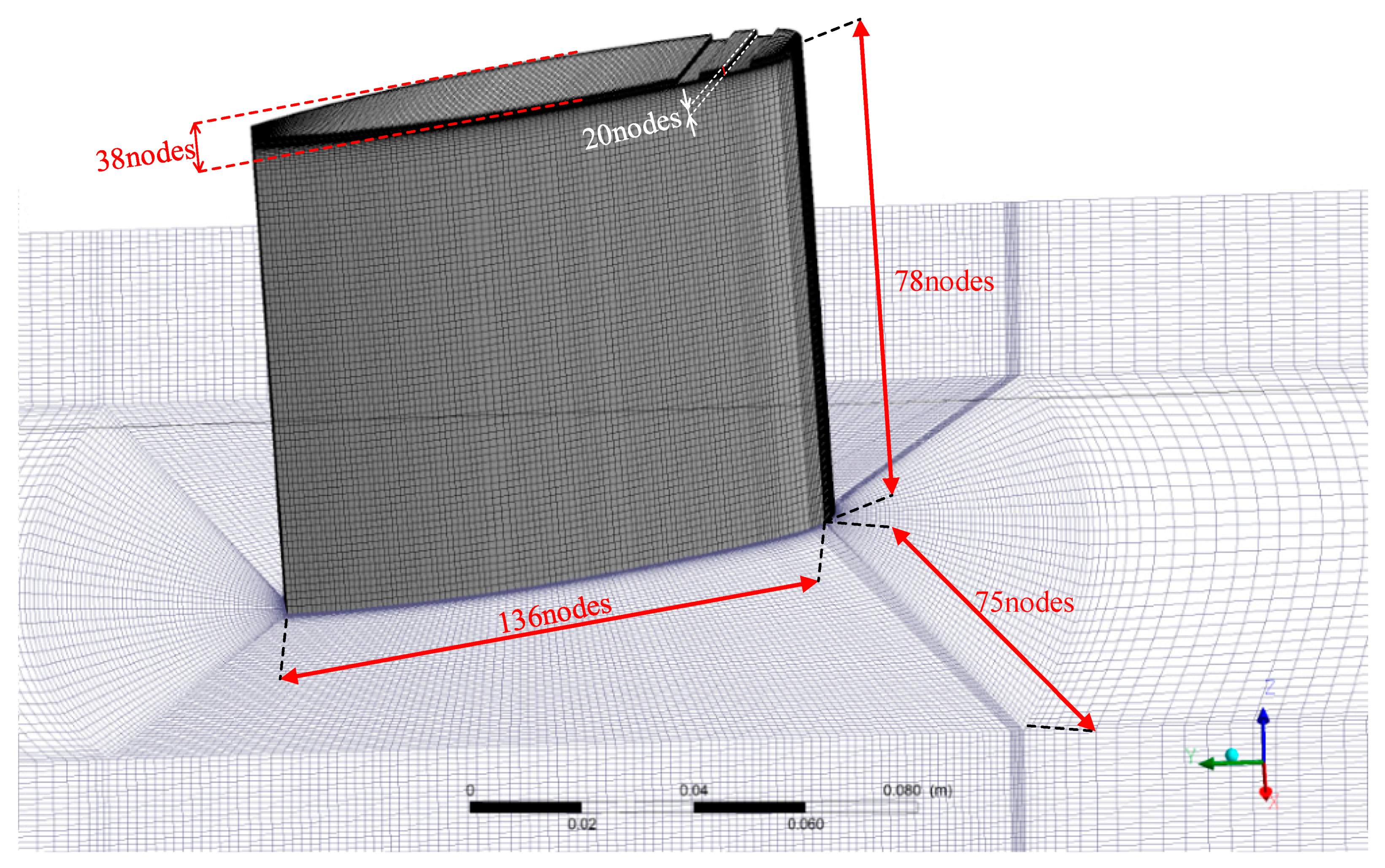
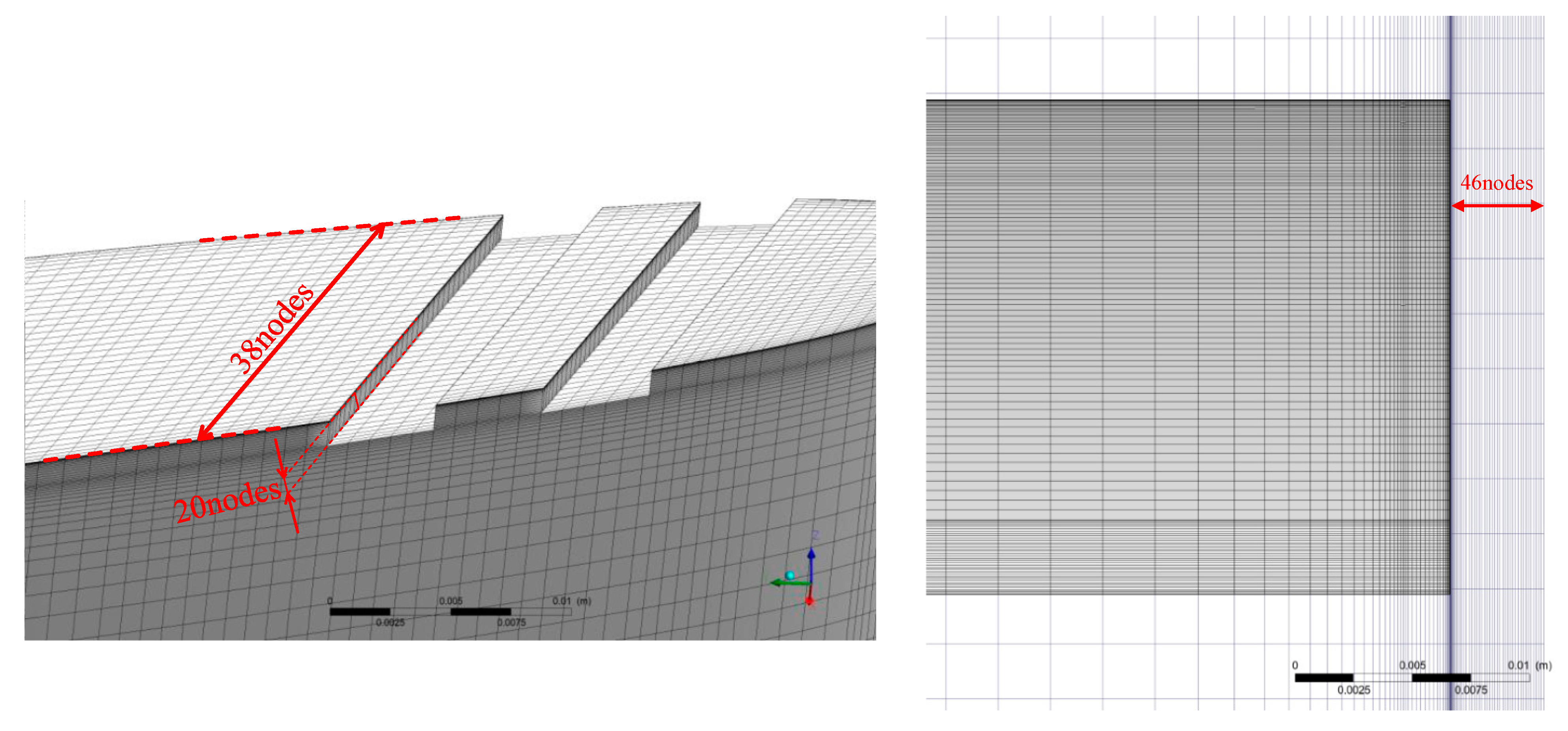

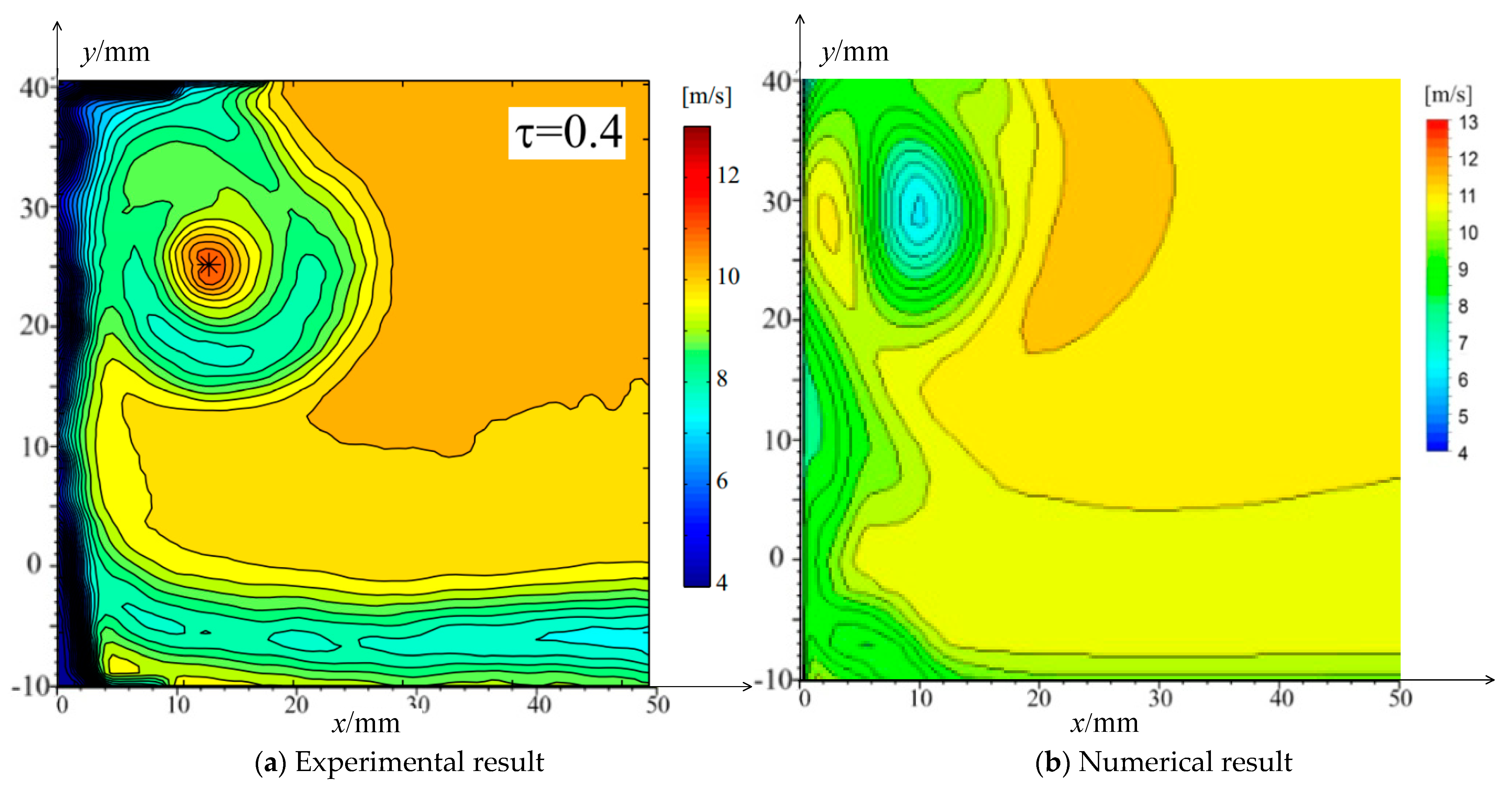
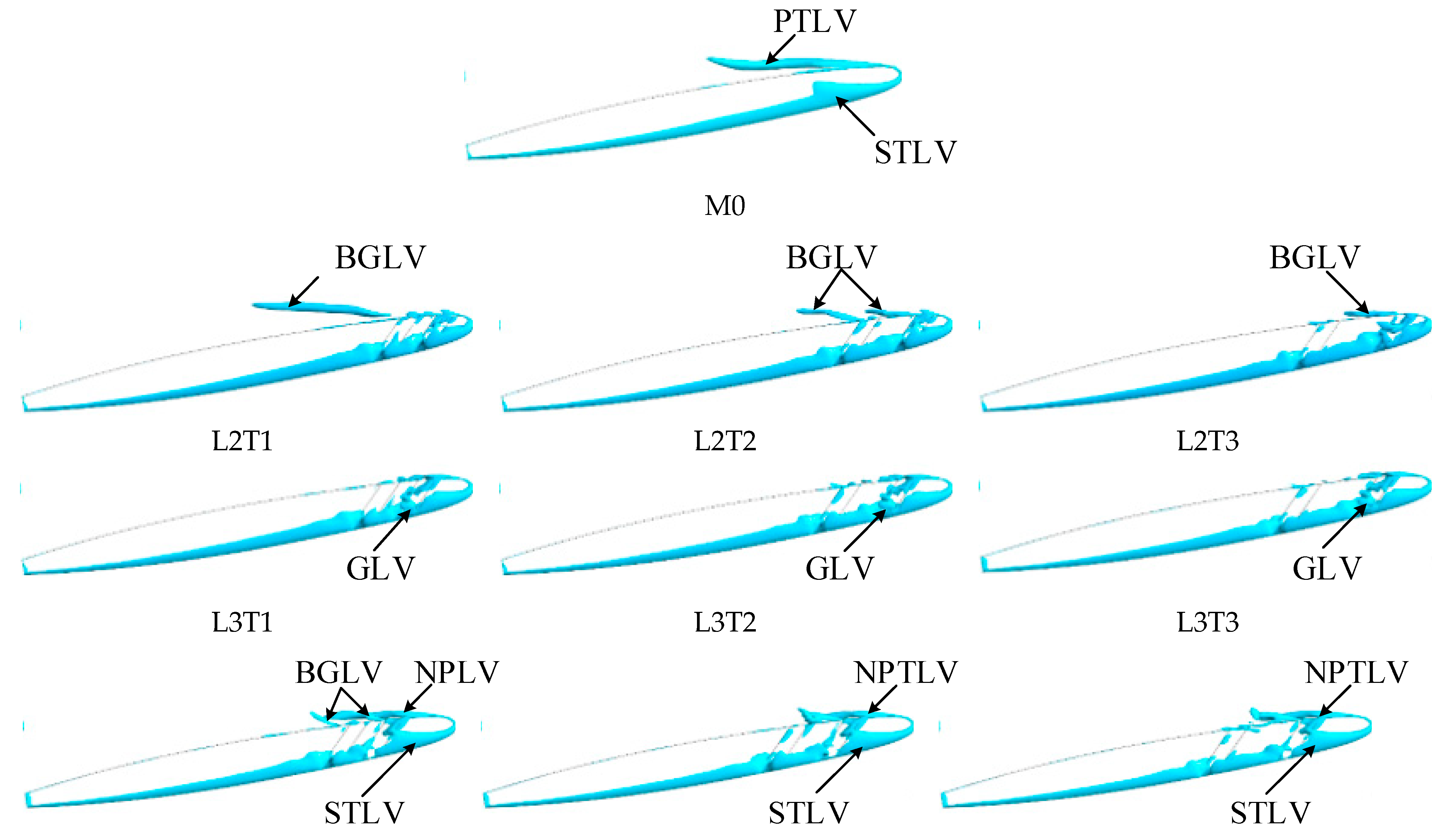
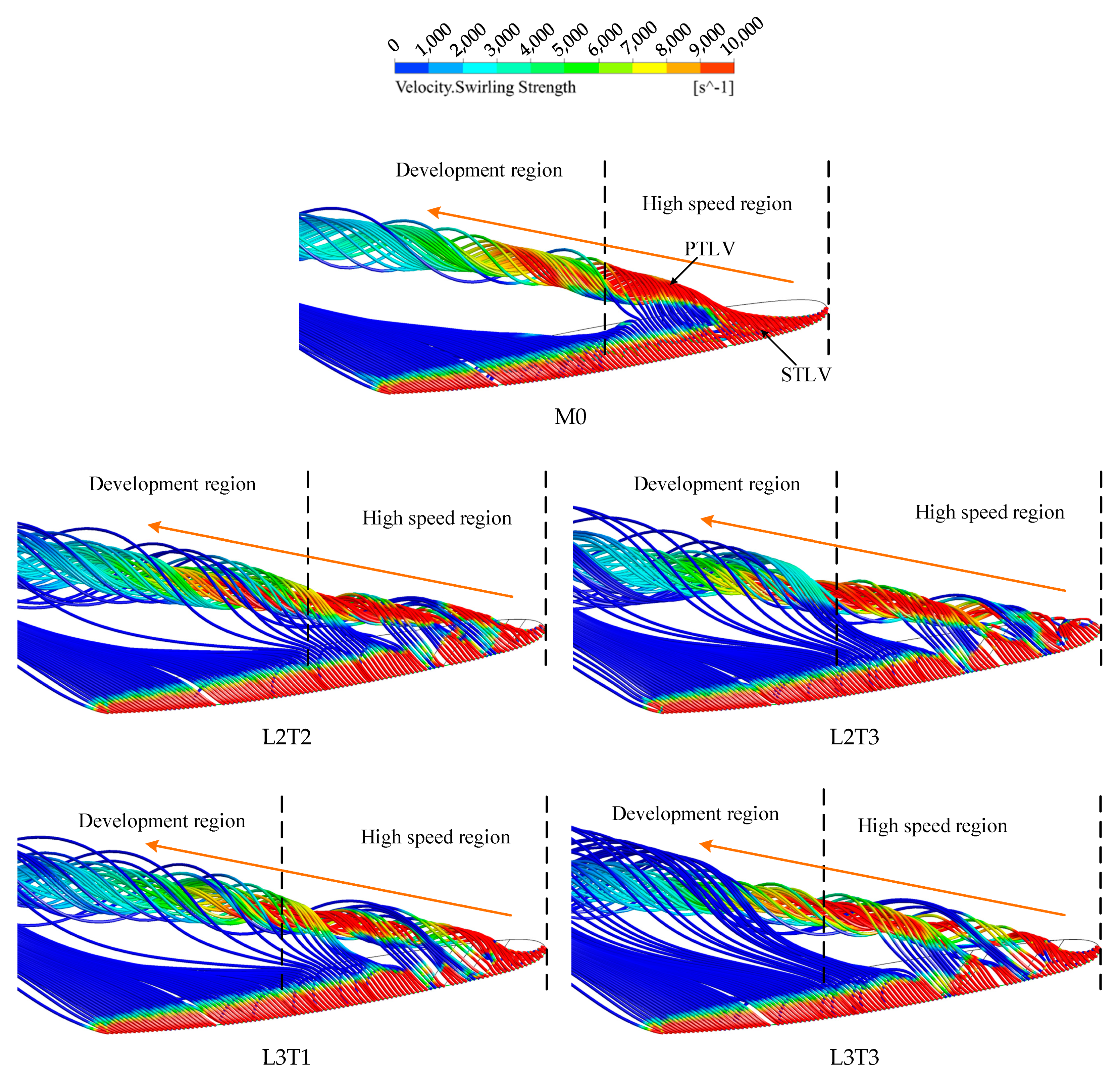

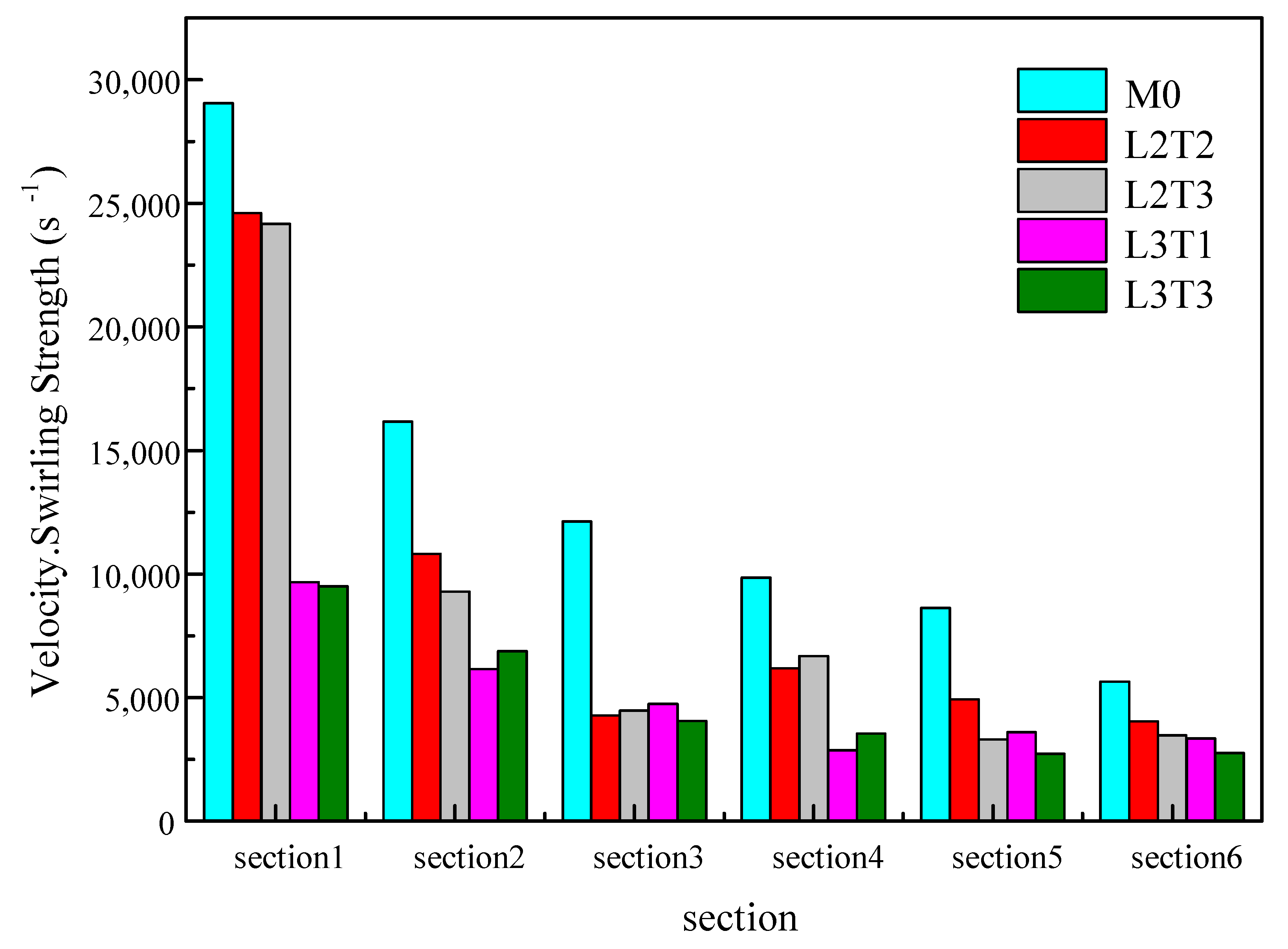

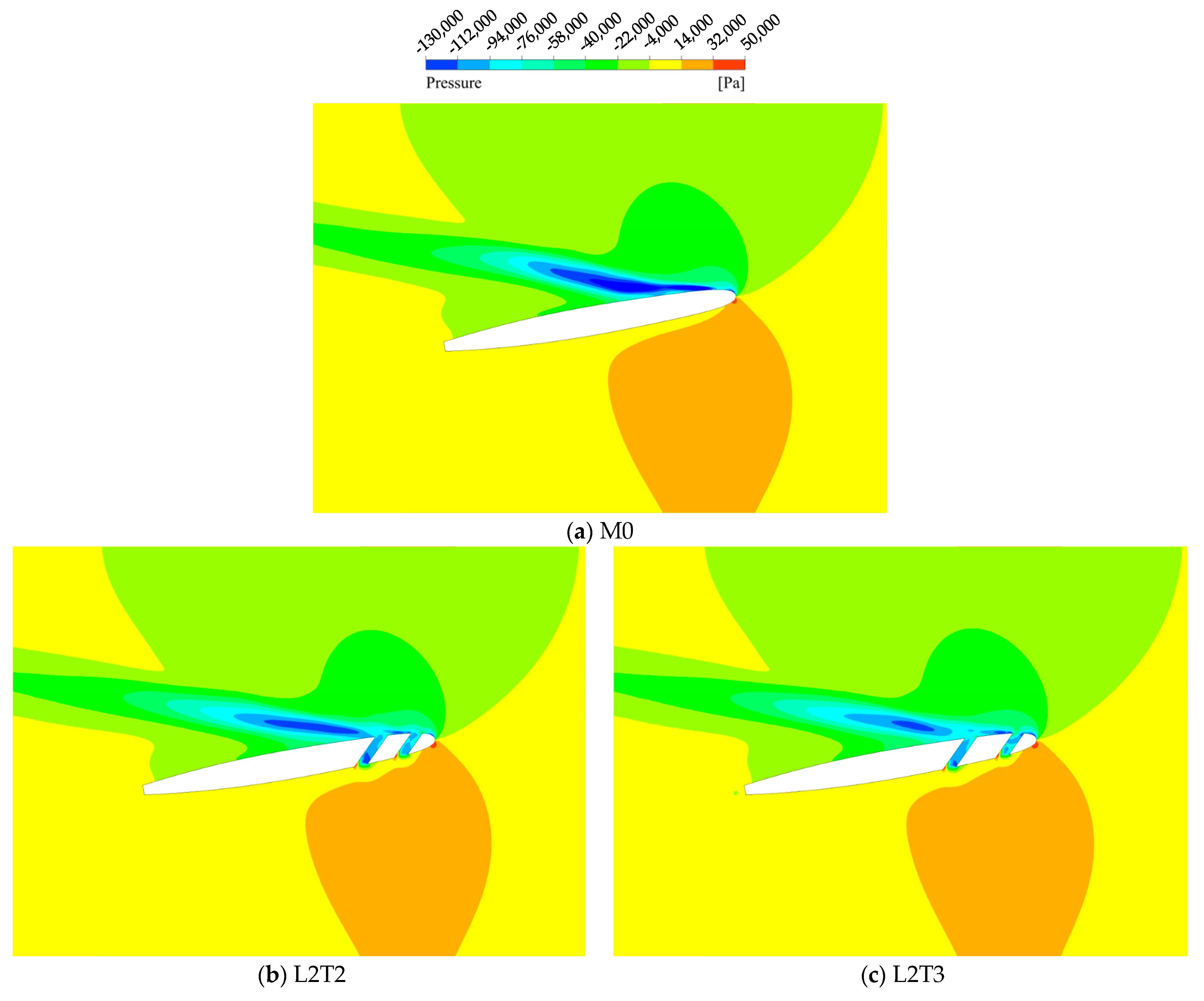
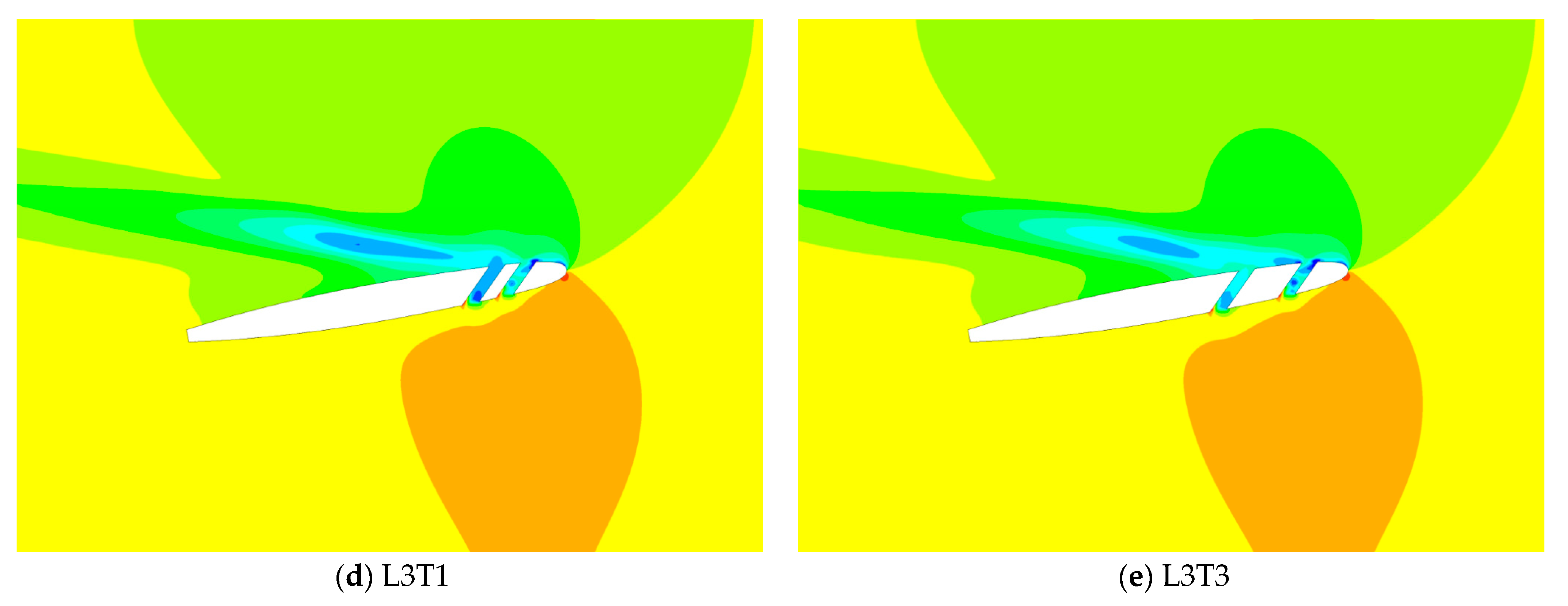
| Spacing | 1/23c | 2/23c | 3/23c | |
|---|---|---|---|---|
| Location | ||||
| 2/23c | L2T1 | L2T2 | L2T3 | |
| 3/23c | L3T1 | L3T2 | L3T3 | |
| 4/23c | L4T1 | L4T2 | L4T3 | |
| Mesh Scheme | Mesh1 | Mesh2 | Mesh3 |
|---|---|---|---|
| Mesh number | 4.2 × 106 | 5.2 × 106 | 6.2 × 106 |
| Lift | 852.21 | 860.85 | 861.05 |
| Drag | 40.82 | 39.91 | 39.79 |
| Lift-Drag | 20.88 | 21.57 | 21.64 |
| Scheme | M0 | L2T1 | L2T2 | L2T3 | L3T1 | L3T2 | L3T3 | L4T1 | L4T2 | L4T3 | |
|---|---|---|---|---|---|---|---|---|---|---|---|
| Area (mm2) | |||||||||||
| Area of vortex | 2514 | 2566 | 2501 | 2484 | 2440 | 2480 | 2473 | 2550 | 2553 | 2547 | |
| Item | M0 | L2T1 | L2T2 | L2T3 | L3T1 | L3T2 | L3T3 | L4T1 | L4T2 | L4T3 |
|---|---|---|---|---|---|---|---|---|---|---|
| Lift-drag | 21.64 | 20.78 | 20.74 | 21.13 | 20.69 | 20.63 | 20.68 | 20.53 | 20.47 | 20.70 |
| Change of Lift-drag (%) | −4.00 | −4.15 | −2.35 | −4.38 | −4.62 | −4.42 | −5.13 | −5.04 | −4.35 | |
| Drag | 39.79 | 41.36 | 41.42 | 41.03 | 41.54 | 41.60 | 41.51 | 41.76 | 41.86 | 41.46 |
| Lift | 861.1 | 859.2 | 859.1 | 867.0 | 859.5 | 858.6 | 858.6 | 857.3 | 856.9 | 858.1 |
| Change of Lift (%) | −0.22 | −0.35 | 0.45 | −0.53 | −0.75 | −0.87 | −1.13 | −1.29 | −1.27 |
Publisher’s Note: MDPI stays neutral with regard to jurisdictional claims in published maps and institutional affiliations. |
© 2021 by the authors. Licensee MDPI, Basel, Switzerland. This article is an open access article distributed under the terms and conditions of the Creative Commons Attribution (CC BY) license (https://creativecommons.org/licenses/by/4.0/).
Share and Cite
Chen, Y.; Zhang, W.; Fang, D.; Sun, M.; Liu, J.; Song, D.; Zhang, X. Vortex Suppression and Flow Pattern Analysis of a Hydrofoil with Parallel Grooves. Processes 2021, 9, 816. https://doi.org/10.3390/pr9050816
Chen Y, Zhang W, Fang D, Sun M, Liu J, Song D, Zhang X. Vortex Suppression and Flow Pattern Analysis of a Hydrofoil with Parallel Grooves. Processes. 2021; 9(5):816. https://doi.org/10.3390/pr9050816
Chicago/Turabian StyleChen, Yue, Wei Zhang, Dehong Fang, Mingkang Sun, Jian Liu, Daoyuan Song, and Xiaoping Zhang. 2021. "Vortex Suppression and Flow Pattern Analysis of a Hydrofoil with Parallel Grooves" Processes 9, no. 5: 816. https://doi.org/10.3390/pr9050816
APA StyleChen, Y., Zhang, W., Fang, D., Sun, M., Liu, J., Song, D., & Zhang, X. (2021). Vortex Suppression and Flow Pattern Analysis of a Hydrofoil with Parallel Grooves. Processes, 9(5), 816. https://doi.org/10.3390/pr9050816






